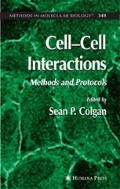Abstract
Adhesive interactions between cells regulate tissue integrity as well as the process of inflammatory cell recruitment. Such intercellular interactions are regulated by adhesion receptors and can be homotypic, that is, between cells of the same type, for example, between adjacent endothelial cells in the vasculature, as well as heterotypic, that is, between different cells, such as the leukocyte endothelial interactions that take place during leukocyte extravasation. Emerging evidence points to the importance of the family of junctional adhesion molecules (JAMs), which are localized in interendothelial contacts and are implicated in the regulation of leukocyte extravasation. JAMs are members of the immunoglobulin superfamily and can undergo both homophilic and heterophilic interactions. This chapter deals with the role of JAMs in the regulation of adhesive interactions between vascular cells.
Access this chapter
Tax calculation will be finalised at checkout
Purchases are for personal use only
References
Bazzoni, G. (2003) The JAM family of junctional adhesion molecules. Curr. Opin. Cell. Biol. 15, 525–530.
Ebnet, K., Suzuki, A., Ohno, A., and Vestweber, D. (2004) Junctional Adhesion Molecules (JAMs): more molecules with dual functions? J. Cell. Sci. 117, 19–29.
Keiper, T., Santoso, S., Nawroth, P. P., Orlova, V., and Chavakis, T. (2005) The role of junctional adhesion molecules in Cell-Cell interactions. Histol. Histopathol. 20, 197–203.
Kornecki, E., Walkowiak, B., Naik, U. P., and Ehrlich, Y. H. (1990) Activation of human platelets by a stimulatory monoclonal antibody. J. Biol. Chem. 265, 10,042–10,048.
Sobocka, M. B., Sobocki, T., Banerjee, P., et al. (2000) Cloning of the human platelet F11-receptor: a cell adhesion molecule member of the immunoglobulin superfamily involved in platelet aggregation. Blood 95, 2600–2609.
Palmeri, D., van Zante, A., Huang, C. C., Hemmerich, S., and Rosen S. D. (2000) Vascular endothelial junction-associated molecule, a novel member of the immunoglobulin superfamily, is localized to intercellular boundaries of endothelial cells. J. Biol. Chem. 275, 19,319–19,345.
Aurrand-Lions, M. A., Duncan, L., Ballestrem, C., and Imhof, B. A. (2001) JAM-2, a novel immunoglobulin superfamily molecule, expressed by endothelial and lymphatic cells. J. Biol. Chem. 276, 2733–2741.
Aurrand-Lions, M. A., Johnson-Leger, C., Wong, C., DuPasquier, L., and Imhof, B. A. (2001) Heterogeneity of endothelial junctions is reflected by differential and specific subcellular localization of three JAM family members. Blood 98, 3699–3707.
Santoso, S., Sachs, U. J. H., Kroll, H., et al. (2002) The junctional adhesion molecule 3 (JAM-3) on human platelets is a counterreceptor for the leukocyte integrin Mac-1. J. Exp. Med. 196, 679–691.
Zen, K., Babbin, B. A., Liu, Y., Whelan, J. B., Nusrat, A., and Parkos, C. A. (2004) JAM-C is a component of desmosomes and a ligand for CD11b/CD18-mediated neutrophil transepithelial migration. Mol. Biol. Cell. 15, 3926–3937.
Bazzoni, G., Martinez-Estrada, O. M., Orsenigo, F. M., Cordenonsi, M., Citi, S., and Dejana E. (2000). Interaction of junctional adhesion molecule with the tight junction components ZO-1, cingulin, and occludin. J. Biol. Chem. 275, 20,520–20,526.
Ebnet, K., Schulz, C. U., Meyer Zu Brickwedde, M. K., Pendl, G. G., and Vestweber, D. (2000) Junctional adhesion molecule interacts with the PDZ domain-containing proteins AF-6 and ZO-1. J. Biol. Chem. 275, 27,979–27,988.
Hamazaki, Y., Itoh, M., Sasaki, H., Furuse, M., and Tsukita, S. (2002) Multi-PDZ domain protein 1 (MUPP1) is concentrated at tight junctions through its possible interaction with claudin-1 and junctional adhesion molecule. J. Biol. Chem. 277, 455–461.
Ebnet, K., Suzuki, A., Horikoshi, Y., et al. (2001) The cell polarity protein ASIP/PAR-3 directly associates with junctional adhesion molecule (JAM). EMBO J. 20, 3738–3748.
Ebnet, K., Aurrand-Lions, M., Kuhn, A., et al. (2003) The junctional adhesion molecule (JAM) family members JAM-2 and JAM-3 associate with the cell polarity protein PAR-3: A possible role for JAMs in endothelial cell polarity. J. Cell. Sci. 116, 3879–3891.
Fanning, A. S., Jameson, B. J., Jesaitis, L. A., and Anderson J. M. (1998) The tight junction protein ZO-1 establishes a link between the transmembrane protein occludin and the actin cytoskeleton. J. Biol. Chem. 273, 29,745–29,753.
Ostermann, G., Weber, K. S., Zernecke, A., Schroeder, A., and Weber, C. (2002) JAM-1 is a ligand of the beta(2) integrin LFA-1 involved in transendothelial migration of leukocytes. Nat. Immunol. 3, 151–158.
Cunningham, S. A., Rodriguez, J. M., Arrate, P. M., Tran, T. M., and Brock, T. A. (2002) JAM2 interacts with alpha4beta1. Facilitation by JAM3. J. Biol. Chem. 277, 27,589–27,592.
Chavakis, T., Keiper, T., Matz-Westphal, R., et al. (2004) The junctional adhesion molecule-C promotes neutrophil transendothelial migration in vitro and in vivo. J. Biol. Chem. 279, 55,602–55,608.
Chavakis, T., Athanasopoulos, A., Rhee, J. S., et al. (2005) Angiostatin is a novel anti-inflammatory factor by inhibiting leukocyte recruitment. Blood 105, 1036–1043.
Author information
Authors and Affiliations
Editor information
Editors and Affiliations
Rights and permissions
Copyright information
© 2006 Humana Press Inc.
About this protocol
Cite this protocol
Chavakis, T., Orlova, V. (2006). The Role of Junctional Adhesion Molecules in Interactions Between Vascular Cells. In: Colgan, S.P. (eds) Cell-Cell Interactions. Methods in Molecular Biology™, vol 341. Humana Press. https://doi.org/10.1385/1-59745-113-4:37
Download citation
DOI: https://doi.org/10.1385/1-59745-113-4:37
Publisher Name: Humana Press
Print ISBN: 978-1-58829-523-1
Online ISBN: 978-1-59745-113-0
eBook Packages: Springer Protocols

